3D PRINTING TECHNOLOGY CAN REVOLUTIONIZE POLICING
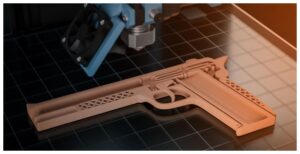
3D printing has the potential to revolutionize policing in several ways. Several movies and books have portrayed the use of 3D printing technology by law enforcement agencies in various ways. In “Robocop” (1987): A classic sci-fi film, the main character, Alex Murphy, is a police officer who is killed in the line of duty and then brought back to life as a cyborg law enforcement officer. One of the key features of his new body is the use of 3D printing technology to create his armored suit and various other parts of his body. Similarly in the futuristic thriller, “Minority Report” (2002): the police department uses 3D printing to create customized weapons for their officers. This technology allows them to produce highly effective weapons that are tailored to the specific needs of each officer.

There are several books as well that have dwelt on use of 3D printing technology for law enforcement purposes. In “The Diamond Age” by Neal Stephenson: 3D printing technology is used by law enforcement agencies to create highly specialized weapons and tools. The main character, a young girl named Nell, is given a book that teaches her how to use 3D printing technology to create her own weapons and tools, allowing her to become a highly skilled fighter. In the science fiction novel “The Three-Body Problem” by Liu Cixin, the police force uses 3D printing technology to create highly advanced robots for law enforcement purposes. These robots are used to patrol the streets and keep the peace in a highly advanced society.

And in the Netflix series, “Altered Carbon” (2018), 3D printing technology is used to create artificial bodies, known as “sleeves”, which are then implanted with the consciousness of a person’s mind. The main character, a former soldier turned detective, is brought back to life in a new sleeve and uses his enhanced abilities to solve crimes in a dystopian future. Overall, these movies and books demonstrate the potential uses of 3D printing technology in law enforcement, from creating specialized weapons and tools to enhancing the capabilities of law enforcement officers themselves. While these portrayals may be fictional, they offer a glimpse into the possibilities of 3D printing technology in the future of law enforcement.

3D printing technology has revolutionized the way forensic investigation, weaponry and equipment production, police training, and community interface are conducted in the world of law enforcement. This remarkable advancement in technology has enabled law enforcement agencies to produce evidence, 3D models, weapon prototypes, and equipment with precision and accuracy.
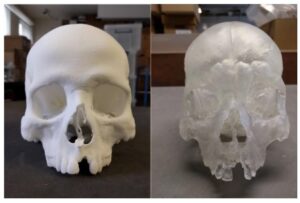
3D printing technology in forensic investigation is used to produce detailed evidence that can be used in criminal cases. It can also be used to create 3D models of crime scenes and to reconstruct facial features of victims and suspects. This technology can even be used to analyze a victim’s body for signs of trauma and for post-mortem examinations. By using 3D printing technology, law enforcement agencies can save time and resources when it comes to collecting, analyzing, and preserving evidence. 3D printing technology is also being used to produce weaponry and equipment for law enforcement. With the help of 3D printing, law enforcement agencies can create weapons, ammunition, body armor, and other tools for use in the field. This technology can be used to quickly produce custom-made weapons and equipment that are tailored to the needs of the agency. In addition, 3D printing technology is being used to create protective gear and uniforms that are lightweight and durable.
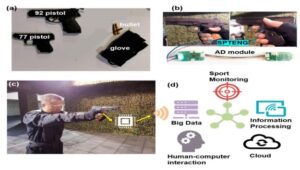
Furthermore, 3D printing is also being used to improve police training. 3D printing technology can be used to create realistic weapons and equipment that can be used in simulations and practice scenarios. This technology can also be used to create 3D models of crime scenes and suspects that can be used to train police officers in how to effectively respond to crime scenes.
Finally, 3D printing technology can be used to improve the community interface by creating 3D models of crime scenes and suspects that can be used to educate the public about the impact of crime on the community. 3D printing can also be used to create 3D models of police officers that can be used to teach children about the role that law enforcement plays in protecting the community.
Overall, 3D printing technology is revolutionizing the way that law enforcement agencies conduct forensic investigation, produce weaponry and equipment, provide police training, and improve the community interface. This remarkable technology is allowing law enforcement agencies to more effectively and efficiently carry out their duties and to provide a safer and more secure environment for all.
3D PRINTING TECH IN FORENSIC INVESTIGATION
The field of forensic investigation is constantly evolving, with new technologies being developed to improve the accuracy and reliability of crime scene analysis. 3D printing is one such technology that has the potential to revolutionize the way forensic investigations are conducted.

Creating Accurate Replicas of Crime Scenes and Evidence:
One of the main advantages of 3D printing in forensic investigations is the ability to create accurate, three-dimensional replicas of crime scenes and evidence. This can be particularly useful in cases where the original crime scene or evidence has been compromised or destroyed, or where a detailed analysis is required.
For example, the New York Police Department’s forensic lab has used 3D printing to create detailed replicas of crime scenes and evidence, including firearms, knives, and bullet casings. This has allowed investigators to recreate the scene of a shooting, for example, and to determine the angle and trajectory of the bullet.
Identifying Suspects:
Another way that 3D printing can be used in forensics is to create accurate, three-dimensional models of suspects based on DNA evidence. This technique, known as DNA phenotyping, involves analyzing DNA samples found at a crime scene to determine physical characteristics such as hair and eye color, facial features, and ethnicity.
This information can then be used to create a 3D model of the suspect, which can help investigators to identify potential suspects and narrow down their search. For example, the Dutch police used 3D printing to create a physical model of a suspect in a rape case, based on DNA evidence found at the crime scene. The model was then used to help identify the suspect, who was later arrested and convicted.
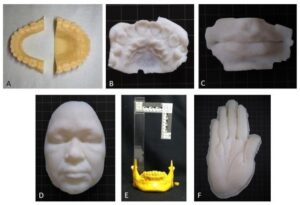
Reconstructing Human Remains:
In cases where human remains are found at a crime scene, 3D printing can be used to create accurate, three-dimensional models of the remains, which can be used to reconstruct the victim’s face or to determine the cause of death.
For example, the University of Dundee in Scotland has used 3D printing to create models of human skulls, which can then be used to reconstruct the victim’s face using techniques such as facial approximation. This can help investigators to identify the victim and to narrow down their search for potential suspects.
In conclusion, 3D printing has the potential to revolutionize the field of forensic investigation by providing law enforcement agencies with a powerful tool for analyzing crime scenes and evidence, identifying suspects, and reconstructing human remains.
While the technology is still relatively new, police in different countries are already using 3D printing in a variety of ways to solve crimes and bring perpetrators to justice. As 3D printing technology continues to evolve, it is likely that its applications in forensics will continue to expand, providing new and innovative ways for law enforcement agencies to investigate and solve crimes.
3D PRINTING TECH FOR THE PRODUCTION OF POLICE EQUIPMENT AND WEAPONRY
3D printing has the potential to revolutionize the way law enforcement agencies approach equipment and weaponry. By allowing for the production of custom-made equipment and tools, 3D printing can help to improve the efficiency and effectiveness of law enforcement operations.
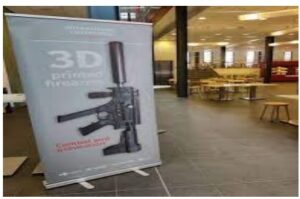
Custom-Made Equipment:
One of the main advantages of 3D printing in law enforcement is the ability to produce custom-made equipment. This can include everything from holsters and handcuffs to more advanced equipment such as drones and robots. By producing equipment that is tailored to the specific needs of a law enforcement agency, 3D printing can help to improve the efficiency and effectiveness of their operations.
For example, the Los Angeles Police Department has used 3D printing to produce custom-made holsters for their officers. These holsters are designed to fit the specific model of firearm carried by each officer, ensuring a secure and comfortable fit. This not only improves officer safety but also helps to reduce the risk of accidental discharge.
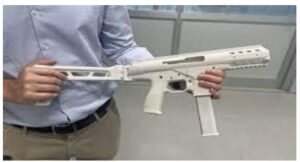
Custom-Made Weaponry:
In addition to equipment, 3D printing can also be used to produce custom-made weapons for law enforcement agencies. This includes everything from pistols and rifles to less-lethal weapons such as pepper spray and stun guns.
For example, the Australian police force has used 3D printing to produce custom-made components for their firearms. This has allowed them to make modifications to their weapons to improve accuracy and reduce recoil, resulting in more effective and efficient use of their firearms.
Advanced Equipment:
3D printing can also be used to produce more advanced equipment such as drones and robots, which can be used to improve the efficiency and effectiveness of law enforcement operations. For example, 3D printing can be used to produce parts for unmanned aerial vehicles (UAVs), which can be used for surveillance and reconnaissance purposes.
The Dubai Police Department has used 3D printing to produce components for their robotic police officer, known as the “Robocop”. The Robocop is equipped with facial recognition technology and can interact with the public in multiple languages, making it a valuable addition to the police force.
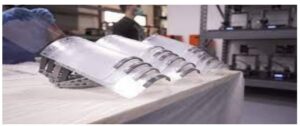
In conclusion, 3D printing has the potential to revolutionize the way law enforcement agencies approach equipment and weaponry. By allowing for the production of custom-made equipment and tools, 3D printing can help to improve the efficiency and effectiveness of law enforcement operations. While the technology is still relatively new, police in different countries are already using 3D printing in a variety of ways to improve their operations. As 3D printing technology continues to evolve, it is likely that its applications in law enforcement will continue to expand, providing new and innovative ways for law enforcement agencies to improve their operations and keep their communities safe.
3D PRINTING TECH FOR TRAINING AND EDUCATION OF LAW ENFORCEMENT OFFICERS
3D printing is a rapidly growing technology that has the potential to revolutionize the way law enforcement personnel are trained. By creating realistic training tools and scenarios, 3D printing can help to improve the quality and safety of law enforcement training.
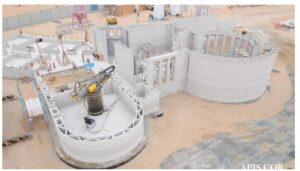
Realistic Training Tools:
One of the main advantages of 3D printing in law enforcement is the ability to create realistic training tools. This can include everything from firearms and explosive devices to simulated environments and vehicles. By producing training tools that are as close to the real thing as possible, 3D printing can help to improve the quality and safety of law enforcement training.
For example, the New Zealand police force has used 3D printing to create replica firearms and other weapons for training purposes. These replicas are made to exact specifications and are indistinguishable from the real thing, allowing officers to train in a safe and controlled environment.
Simulated Environments:
In addition to training tools, 3D printing can also be used to create simulated environments for law enforcement personnel. This can include everything from simulated buildings and rooms to entire cityscapes.
For example, the Australian Federal Police has used 3D printing to create a simulated airport environment for their officers to train in. This environment includes replica airplanes, baggage conveyors, and other features commonly found in airports. This allows officers to train for a variety of scenarios in a realistic and controlled environment.
Custom-Made Training Tools:
Another advantage of 3D printing in law enforcement training is the ability to produce custom-made training tools. This can include everything from training dummies to specialized tools and equipment.
For example, the United States Marine Corps has used 3D printing to produce custom-made training dummies that can be used to simulate injuries and other scenarios. These dummies are designed to be as realistic as possible and can be customized to meet the specific training needs of each unit.
In conclusion, 3D printing has the potential to revolutionize the way law enforcement personnel are trained. By creating realistic training tools and scenarios, 3D printing can help to improve the quality and safety of law enforcement training. While the technology is still relatively new, police in different countries are already using 3D printing in a variety of ways to enhance their training programs. As 3D printing technology continues to evolve, it is likely that its applications in law enforcement training will continue to expand, providing new and innovative ways for law enforcement personnel to improve their skills and keep their communities safe.
3D PRINTING TECH FOR IMPROVING POLICE-COMMUNITY RELATIONS
3D printing has the potential to transform the way law enforcement agencies interact with their communities. By using this technology to create custom-made items, law enforcement can improve their relationships with the public and create positive interactions.

Creating Toys and Other Items for Children:
One of the most popular ways that law enforcement agencies are using 3D printing to engage with their communities is by creating toys and other items for children. By producing customized items, police departments can build positive relationships with young people and help to create a positive image of law enforcement in their communities.
For example, the Dubai Police Force has used 3D printing to create miniature versions of their patrol cars that can be given to children during community events. These toys are a hit with kids and help to build trust and positive relationships between law enforcement and the community.
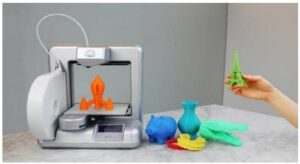
Producing Prosthetic Limbs:
Another way that law enforcement agencies can use 3D printing to engage with their communities is by producing prosthetic limbs for individuals in need. By using 3D printing to create customized prosthetics, law enforcement agencies can improve the lives of those in their communities who may have suffered injuries or disabilities.
For example, the South African Police Service has partnered with a local university to use 3D printing to produce prosthetic limbs for individuals who cannot afford traditional prosthetics. This program has helped to improve the lives of many people in the community and has created a positive image of law enforcement in the process.
Creating Community Safety Tools:
Another way that law enforcement agencies can use 3D printing to engage with their communities is by creating community safety tools. This can include everything from safety devices and alarm systems to educational materials and information pamphlets.
For example, the Massachusetts State Police has used 3D printing to produce specialized tools for their bomb squad. By creating customized tools that are unique to their needs, the bomb squad can operate more efficiently and effectively, improving the safety of the community.

In conclusion, 3D printing has the potential to transform the way law enforcement agencies interact with their communities. By using this technology to create customized items, law enforcement can build positive relationships with their communities and improve the lives of those in need. While the technology is still relatively new, police in different countries are already using 3D printing in a variety of ways to engage with their communities. As 3D printing technology continues to evolve, it is likely that its applications in community engagement will continue to expand, providing new and innovative ways for law enforcement to build trust and positive relationships with their communities.
CONCLUSION
3D Printing technology is revolutionizing the way law enforcement is conducted around the world. It has been used in a variety of ways including FORENSIC INVESTIGATION, production of weaponry and equipment, and even police training. 3D printing technology has been a great asset for law enforcement, allowing them to be more efficient and cost-effective when tackling criminal activity. In FORENSIC INVESTIGATION, 3D printing technology can be used to recreate crime scenes, reconstruct evidence, and even help solve cold cases. By using the data from a crime scene, 3D printing can create an accurate replica and allow investigators to better visualize the scene. This allows them to better understand what happened and give them the information they need to solve the case. 3D printing technology can also be used to produce weaponry and equipment for law enforcement. This can include everything from firearms to body armor. 3D printed weapons and equipment are more affordable and often more effective than traditional equipment. This allows law enforcement agencies to get the best gear for their officers, while also reducing costs. Lastly, 3D printing technology can be used for police training. By creating realistic and interactive scenarios, officers can practice responding to different situations and learn to think on their feet. This can help them be better prepared for real-life situations and help improve their community interface.
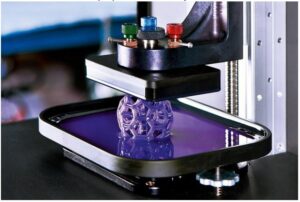
In conclusion, 3D printing technology is a valuable tool for law enforcement. It can be used in FORENSIC INVESTIGATION, production of weaponry and equipment, and even police training. This technology has allowed law enforcement to be more efficient, cost-effective, and better prepared to deal with criminal activity. It has also improved the community interface, allowing officers to better connect with their communities. 3D printing technology is a great asset for law enforcement and will continue to be a valuable tool in the future.
 Dr K. Jayanth Murali is a retired IPS officer and a Life Coach. He is the author of four books, including the best-selling 42 Mondays. He is passionate about painting, farming, and long-distance running . He has run several marathons and has two entries in the Asian book of Records in full and half marathon categories. He lives with his family in Chennai, India. When he is not running, he is either writing or chilling with a book.
Dr K. Jayanth Murali is a retired IPS officer and a Life Coach. He is the author of four books, including the best-selling 42 Mondays. He is passionate about painting, farming, and long-distance running . He has run several marathons and has two entries in the Asian book of Records in full and half marathon categories. He lives with his family in Chennai, India. When he is not running, he is either writing or chilling with a book.
